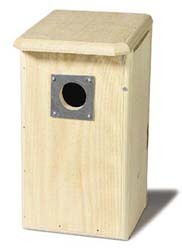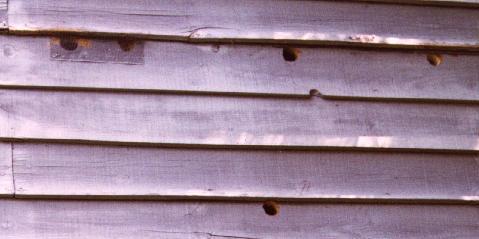Keep Woodpeckers Off Your House

Courtship rituals, followed by the spring nesting season, are a very busy time for our birds. The race is on to impress a future mate and secure your place in the next generation of your species. In order to do that, you must be bigger, prettier, stronger...and louder.
Woodpeckers love to drum on anything that will amplify their sound and let everyone hear it. At our property in the Cariboo, the sapsuckers’ favourite tapping spots are the metal plates on the telephone poles. Here in more urban areas, the Northern Flickers love to drum on chimneys and metal flashing. The metal makes a great sound as far as the woodpeckers are concerned but unfortunately it also echos (very loudly) inside the same house. The good news is this usually doesn’t last very long before the male moves off with his lady love. The bad news, sometimes they decide that the side of your house would also be a good spot for a nest.
There are several things that you can do to prevent woodpeckers from using your house as either a sounding board or possible home. You can either scare them away or make it difficult for them to access the interesting spots but these must be started as soon as he shows an interest.
Scaring Woodpeckers
- Scaring woodpeckers may be successful if started promptly. Scaring the woodpeckers from the house or area relies upon the bird's response to danger or unpleasant experiences. Spray the woodpecker with water from a garden or high-pressure water hose.
- Light pie plates and metal can lids can be suspended on a string. One end of the string can be near a convenient window or door where the line can be jerked whenever the bird appears.
- Attach string to the ends of aluminum foil strips cut two to three inches in width and two to three feet in length and hang from damaged or tapping sites.
- Pinwheels with reflective vanes may be attached at tapping or damaged sites. These must rotate in order to be a deterrent.
- Models or silhouettes of snakes, owls or hawks may be the least effective unless they are hung to move in the breeze and/or in conjunction with playing recorded calls of birds of prey.
Excluding Woodpeckers
- Cover the site with plastic or nylon netting or hardware cloth. Permanent installation of hardware cloth or other screening may be the
 best solution when woodpeckers make repeated attempts over several years to make holes or nests.
best solution when woodpeckers make repeated attempts over several years to make holes or nests. - Metallic or wooded surfaces used for drumming may be wrapped or covered with cloth or foam. An alternative tapping site or surface such as a wooden box or metal cylinder hung in a less annoying location may be considered.
- Placing a woodpecker house over the area if the bird is interested in nesting may encourage the bird to stop creating another hole.

